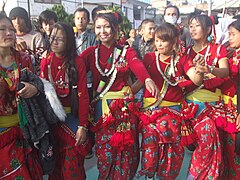| Udhauli | |
|---|---|
 Udhauli celebration by Kirat Sunuwar people | |
| Observed by | Kirat communities |
| Type | Kirat festival |
| Observances | Prayers and religious rituals |
| Date | purnima (Full Moon Day) of Mangshir[1] |
| Frequency | Annual |
Udhauli (उधौली) is a festival of the Kirat communities of Kirati people specially celebrated by Sunuwar, Limbu,Yakkha, Khambu Rai etc. of Nepal, India and other different countries around the world where these indigenous people (Kirati People) resides. It is celebrated every year marking the migration phase downwards towards the low-elevation regions when the winter season arrives. The migration from the low-elevation areas upwards to hilly areas is called Ubhauli (upwards), which is also an annual festival of these communities[2] On the Udhauli festival day, the Kirat people offer thanks to mother nature for providing a good harvest.

Udhauli festival is celebrated by all Kirat people. It is believed that from this day the winter season starts. So people, birds, and animals migrate from cold regions to warmer regions. It's mainly celebrated in the eastern region of Nepal by dancing an exotic dance called Sakewa or commonly known as ''Sakela''. The dance is very popular in Nepal and is performed by dancing harmoniously in a circle with the beat of Dhol/drum, Jhyamta/cymbals etc. Sakela's dance steps were passed down from ancestor that had been copied from the life style of animals and their behaviors.

During the dance each tribe of kirat communities perform their own dance steps according to their sub clans. As sakela is a dance for respecting the mother earth, it is believed to please nature as appreciating nature's gift to human. So, in each steps of Sakela the dancer shows how civilization began and how kirati people learned to live in harmony with animals and birds.
The main destinations for the Sakela are Khotang , Bhojpur , Dharan, Dhankuta, Pathari, Kanepokhari, Kerabari etc. This event of the Kirat people has also been stated in the Mundhum (holy book of the Kirat people).[3]
See also[edit]
References[edit]
- ^ https://myrepublica.nagariknetwork.com/news/udhauli-festival-being-observed-today/
- ^ "Udhauli Festival, December 02". www.nepaltravelnews.com.
- ^ "Udhauli and Ubhauli festivals". The Himalayan Times. December 9, 2015.
Well, that’s interesting to know that Psilotum nudum are known as whisk ferns. Psilotum nudum is the commoner species of the two. While the P. flaccidum is a rare species and is found in the tropical islands. Both the species are usually epiphytic in habit and grow upon tree ferns. These species may also be terrestrial and grow in humus or in the crevices of the rocks.
View the detailed Guide of Psilotum nudum: Detailed Study Of Psilotum Nudum (Whisk Fern), Classification, Anatomy, Reproduction